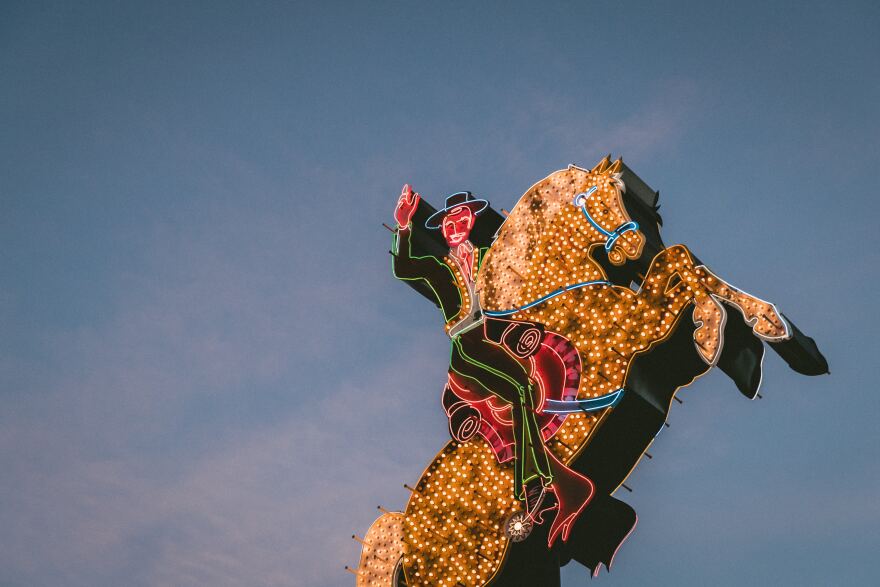The science of neon hasn't changed in over a century. What charged the gas to life as a 1900's advertising medium still burns it brightly today. For KUNR's detailed series on neon, Holly Hutchings traveled to our counterpart in the South and spoke with a physicist about what he calls, lightning in a bottle.
On East Fremont Street in Las Vegas, throwback signs, like a glittering red slipper and a huge vivid blue martini glass, adorn the medians. I’m here to talk about how these signs work with Ben McGee, who works at the Department of Energy’s Aerial Measuring Systems group as a senior scientist.

“I think neon is awesome," McGee said. "I'm old enough to have early memories of Fremont Street before they covered it. The classic Rat Pack Fremont Street, you know, just bathed in neon light. It’s this classic warm sense of being flooded with a very different kind of light than we tend to see now. For me, neon screams pure, original Vegas.”
Now, he works on nuclear science and NASA rockets, but has previously shared his geek expertise on the small screen. He’s made brainy contributions on a myriad of shows on four different networks, from the Science Channel to the History Channel. An episode called “World Access” on the Travel Channel focused on neon signs; what makes them tick, the craftsmanship, science and art required to make them.
Basically, he knows his neon, and I’m about to get schooled on it on his home turf - downtown Vegas.
“The artificial version of a lightning bolt we've started to call neon signs, neon tubes," he said. "And the idea there is that if you trap a gas inside a glass tube and dump a bunch of electricity into it, eventually there's a point where that gas can't hold on anymore and that gas will basically give up and it can't hold on and it'll flash. And that's literally the glow of a neon sign.”
Creating a neon sign requires less manufacturing impact than most modern lighting, which requires toxic metals, huge facilities and tons of circuit boards. But, of course, there are some drawbacks. He says neon signs are legendarily inefficient from an energy perspective because they’re dumping tons of electricity into the air.
“There's a major, major energy penalty for running something like a neon sign," McGee said. "And there's also a heat penalty, they also get hot. And they can break in different ways. And they're pressurized gas."
You could laundry list the negatives when it comes to energy efficiency, but McGee says that's not the only way to think about neon. He gives the example of listening to music. It's obviously more effiecient to throw on headphones and press play...
"But I think everyone would agree that it's way more engaging and visceral to listen to live music, a live band, a live orchestra. But it's really inefficient!" he said. "You've got to pay the band, you've got to have a venue, you've got to have the space. So, sure, is neon more efficient than LED? Yeah. But it also captures something visceral. You're generating this light that's literally like lightning in a bottle, and there's something that draws us to it for that reason.”
We wrap up our chat with the backdrop of the glitzy Fremont Street Experience behind. In this area, every building is bursting with bright lights, from the Walgreens to the Golden Nugget. This area is crafted to keep this iconic look going today. The City of Las Vegas has gone so far at to require standards so that new signage continue the neon tradition and remaining signage is preserved. As a destination nationally recognized for its vintage cool factor, they want to ensure that aesthetic continues.







